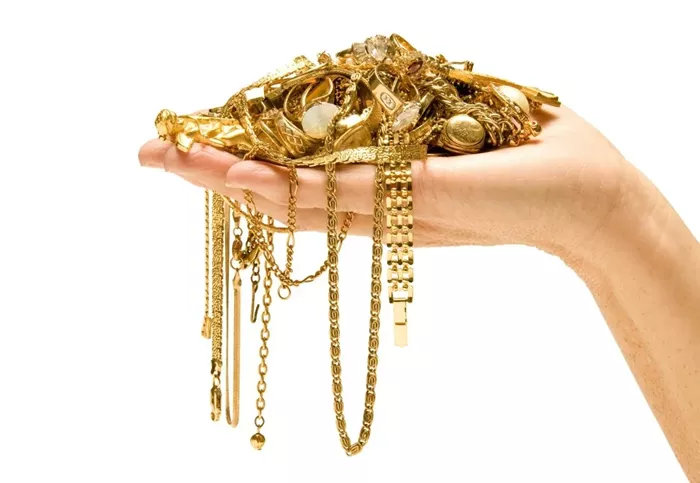Gold jewelry is often passed down through generations or purchased as an investment. But not all gold-looking items are real. Fake gold, or gold-plated metal, can deceive the untrained eye. Confirming whether your jewelry is genuine gold helps you determine its value, avoid scams, and protect your investment.
Understanding Gold Purity
What Is Karat?
Gold purity is measured in karats (K). Pure gold is 24K, meaning 24 out of 24 parts are gold. Lower karats like 18K or 14K include other metals like silver, copper, or zinc. These blends make gold harder and more affordable.
Common Gold Karat Marks
The most common purities used in jewelry are:
- 24K: 99.9% pure gold
- 22K: 91.6% gold
- 18K: 75% gold
- 14K: 58.5% gold
- 10K: 41.7% gold
Ways to Tell If Jewelry Is Gold
1. Look for a Hallmark
Most genuine gold jewelry includes a small stamped mark called a hallmark. It shows the karat weight or gold content.
Typical hallmark examples:
- “18K”, “14K”, or “10K”
- “750” (18K), “585” (14K), or “417” (10K)
Use a magnifying glass to check for these marks. Note that older or handmade pieces may not be stamped.
2. Check for Discoloration or Fading
Genuine gold doesn’t rust or tarnish. If your jewelry shows green or black spots, it may be gold-plated or fake. Also, if the color wears off at edges or where it touches your skin, it’s likely not solid gold.
3. Use a Magnet Test
Gold is not magnetic. Bring a strong magnet near the item. If it sticks, it’s likely made of another metal. However, some fake gold contains non-magnetic materials, so this test alone isn’t enough.
4. Perform a Float Test
Drop the jewelry in a glass of water. Real gold is heavy and sinks straight to the bottom. If it floats or moves slowly, it may not be real gold.
5. Use a Nitric Acid Test
Nitric acid tests are more accurate. You can buy an acid testing kit online. Scratch a small hidden area on the jewelry and apply a drop of acid. If the spot turns green, it’s not gold. If there’s no reaction, it’s likely genuine.
6. Try the Ceramic Plate Test
Rub your jewelry on an unglazed ceramic plate. Real gold will leave a gold streak. Fake gold will leave a black or gray mark. Be careful not to scratch your jewelry.
7. Bite Test: Old but Risky
Pure gold is soft and will show bite marks. This method is risky and can damage your teeth or the jewelry. Not recommended for accurate testing.
8. Have It Professionally Appraised
The safest method is to bring your jewelry to a certified jeweler or appraiser. They can test purity with professional tools like electronic testers, XRF machines, or spectrometers.
How to Tell If Gold Is Plated or Solid
Visual and Weight Differences
Gold-plated jewelry may show signs of wear where the gold layer rubs off. It also feels lighter than solid gold. Real gold has a distinct, warm yellow color, while plated items may appear shinier or have a different hue underneath.
Markings on Plated Jewelry
Look for markings like:
- “GP” (gold plated)
- “GF” (gold filled)
- “HGE” (heavy gold electroplate)
These stamps indicate that the jewelry isn’t made of solid gold.
Common Myths About Gold Testing
Myth 1: Color Alone Confirms Authenticity
Some metals are made to look like gold. Even experts can’t always tell by color. Always test with more than one method.
Myth 2: Older Jewelry Is Always Real
Not all vintage or antique jewelry is made of real gold. Many imitations exist, even from decades ago.
Myth 3: Higher Karats Are Always Better
While 24K is purer, it’s also softer and less durable. Many people prefer 18K or 14K for everyday wear.
How to Buy Authentic Gold Jewelry
Buy from Trusted Sources
Always buy from reputable jewelers or certified dealers. Ask for a certificate of authenticity when available.
Verify Return and Exchange Policies
A trustworthy seller offers flexible return options. This gives you time to verify the jewelry’s authenticity at home or with an expert.
Understand the Market Price
Gold prices change daily. If a deal seems too good to be true, it probably is. Check the current price of gold per gram or ounce to estimate the value of your item.
Tips for Maintaining Gold Jewelry
Regular Cleaning
Use warm water and mild soap to clean your gold pieces. Avoid harsh chemicals or abrasive cleaners. Dry thoroughly with a soft cloth.
Proper Storage
Store gold jewelry in a soft pouch or lined jewelry box to prevent scratches. Keep each piece separate to avoid tangling or rubbing.
Avoid Exposure to Chemicals
Take off gold jewelry when swimming, bathing, or using household cleaners. Chlorine and other chemicals can damage the gold’s surface.
Conclusion: Trust but Verify
Real gold is a valuable and lasting material. Whether you’re testing an old family heirloom or shopping for a new piece, knowing how to tell if jewelry is gold protects your investment. Combine visual inspection with scientific methods for best results. And when in doubt, consult a professional jeweler.
Related Topics

